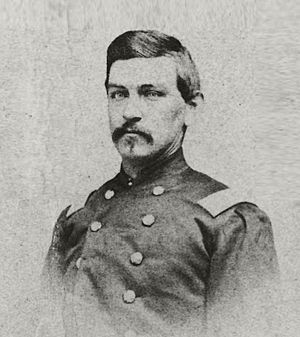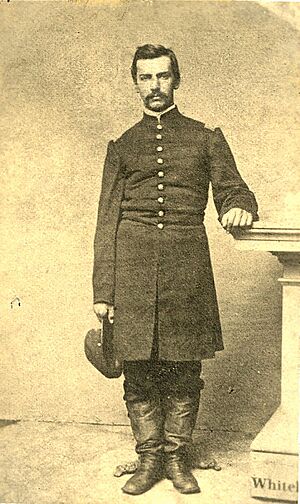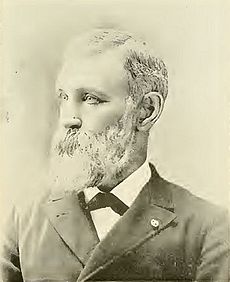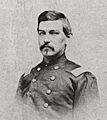Ephraim C. Dawes facts for kids
Quick facts for kids
Ephraim C. Dawes
|
|
|---|---|

1863 photo of Dawes
|
|
| Born | May 27, 1840 Marietta, Ohio |
| Died | April 23, 1895 (aged 54) Cincinnati, Ohio |
| Allegiance | |
| Service/ |
United States Army Union Army |
| Years of service | 1861-1864 |
| Rank | |
| Unit | 53rd Ohio Infantry |
| Battles/wars | American Civil War |
Ephraim Cutler Dawes (May 27, 1840 – April 23, 1895) was an important officer in the Union Army during the American Civil War. He served as a major in the 53rd Ohio Infantry. He also earned the honorary rank of lieutenant-colonel for his brave service.
Dawes fought in many major battles. These included the Battle of Shiloh and the Siege of Vicksburg. He served under famous generals like Ulysses S. Grant and William Tecumseh Sherman. During one battle, Dawes showed great courage. He even stood up to an officer who was scared and confused.
While fighting with General Sherman, Dawes was badly hurt. He was shot in the jaw during the Battle of Dallas. This injury ended his time in the army. He was honorably discharged in 1864.
After the war, Dawes became a successful businessman. He worked with railroad companies. He also loved history, especially the Civil War. He wrote many historical works and gave speeches. Even with his jaw injury, he became a well-known public speaker. He collected one of the largest sets of Civil War books and papers.
Contents
Early Life and Family Connections
Ephraim Dawes was born on May 27, 1840. He grew up near Malta, Ohio. He was the youngest of six children. His parents were Henry and Sarah Cutler Dawes.
His family had a history of important people. His ancestor, William Dawes Jr., rode with Paul Revere. This happened on April 19, 1775, to warn about British troops. Ephraim's grandfather, Judge Ephraim Cutler, was also famous. He helped shape Ohio's early history.

Ephraim's uncle, William P. Cutler, was a big influence on him. His uncle's example inspired Dawes in his public and military life. His older brother, Rufus Dawes, was also a Civil War hero. Rufus fought with the Iron Brigade at the Battle of Gettysburg.
In 1866, Ephraim Dawes married Frances Bosworth. They settled in Cincinnati, Ohio. They did not have any children. Dawes was a member of several history groups. He often spoke and wrote about historical topics.
Military Service in the Civil War
Before joining the army, Dawes went to college. He studied at the University of Wisconsin–Madison and Marietta College. He graduated in 1861. That same year, the Civil War began. Dawes quickly joined the 53rd Ohio Infantry. He started as a First Lieutenant.
His regiment, the 53rd Ohio, was formed in late 1861. They were sent to Paducah, Kentucky in February 1862. There, they joined General William Tecumseh Sherman's division. Dawes fought in some of the war's toughest battles.
Battle of Shiloh: A Test of Courage
Dawes was at the Battle of Shiloh on April 6–7, 1862. This battle in Tennessee was very costly. The 53rd Ohio Infantry fought bravely. They stayed organized even in the chaos. They were at the front of Sherman's battle line.
Dawes later wrote about his experience at Shiloh. He described seeing Confederate officers. He also saw General Patrick Cleburne, a famous Confederate leader. Dawes's account was published in 1896.
During the battle, Dawes saw his commander, Colonel Jesse J. Appler, lose his nerve. Appler yelled for his men to retreat. Dawes was shocked. He risked trouble by refusing to obey. He told Appler, "Colonel, I will not do it!" Appler then ran away. Many troops retreated, but General John Alexander McClernand ordered them back. They formed a new line near the Shiloh Chapel. Dawes helped reorganize his regiment. Colonel Appler was later removed from command.
After Shiloh, the Confederate army escaped to Corinth, Mississippi. Union forces, led by General Henry Halleck, followed them. They began a Siege of Corinth that lasted a month. The Union army captured Corinth in May 1862.
Vicksburg Campaign: Advancing with Grant
In January 1863, Dawes was promoted to Major. He served under General Ulysses S. Grant in the Vicksburg Campaign. This campaign aimed to capture Vicksburg, Mississippi. Vicksburg was a key city on the Mississippi River.
Dawes and the 53rd Ohio fought at Black River. This led to the capture of Vicksburg on July 4, 1863. After Vicksburg, Dawes's regiment advanced on Jackson, Mississippi. They helped capture that city too. Later, they moved to eastern Tennessee. They fought in the Battle of Missionary Ridge.
Atlanta Campaign: A Serious Injury
Dawes then served under General Sherman again. His regiment joined Sherman's advance toward Atlanta in early 1864. They fought in the Battle of Resaca in May 1864. They also fought in the Battle of Dallas.
The fighting around Dallas, Georgia, happened from May 26 to June 4, 1864. Dawes's regiment was part of the Union defense. They fought against Confederate forces. They also took part in the Battle of Kennesaw Mountain and the Battle of Peachtree Creek. Then they joined the Siege of Atlanta.
On May 28, 1864, at the Battle of Dallas, Dawes saw a weak spot in the Union line. He realized Confederates might break through. He rushed to the spot as the enemy attacked. A Minié ball (a type of bullet) hit him in the left side of his lower jaw. It badly damaged his lip, chin, and teeth. He was carried off the field. Despite his pain, he managed to write, "Good for a 60 day furlough?"
Dawes was honorably discharged on October 31, 1864. He suffered for months from his wound. Doctors helped reconstruct his jaw. Even with this serious injury, Dawes later became a talented public speaker.
Life After the War
After leaving the army in 1864, Dawes focused on business and history. He also wrote several books.
Business Ventures
Dawes started in the railroad business. He worked with companies in Illinois, Indiana, and Missouri. He was successful at first. However, he lost his money during the economic crash of 1873. He went bankrupt in 1874.
But Dawes didn't give up. He started over, dealing in railroad supplies. He also helped develop coal fields in Illinois. Soon, he built a large business in Saint Louis and Chicago. He became president of the Saint Louis and Big Muddy Coal Company. This was one of the biggest mining companies in Illinois.
Historical Research and Writings
As a Civil War veteran, Dawes was very interested in its history. He researched and wrote about many events from the war. He often gave speeches to various groups about Civil War topics.
Even with his jaw injury, Dawes was a gifted speaker. People often asked him to speak at events. His speeches, like one at the Army of the Tennessee banquet in 1879, made him famous.
He collected many historical items. He gathered books, letters, and papers about the Civil War. He made sure his collection included both Union and Confederate viewpoints. His collection of Civil War materials was one of the largest in the United States.
Some of Dawes's writings include "The Beginnings of the Ohio Company" and "Sketch of William P. Cutler." He also contributed to "Battles and Leaders of the Civil War." In 1885, he published a book called "Biographical Sketch of Gen. Rufus Putnam." His most famous work is his account of Shiloh, My First Day Under Fire at Shiloh, published in 1896.
Dawes was a trustee of the Ohio History Connection. He was also a member of many historical societies. These included the Cincinnati Historical Society and the Wisconsin Historical Society. He was also active in groups like the Army of Tennessee. Ephraim Dawes passed away at his home in Cincinnati, Ohio, on April 23, 1895.
Images for kids
-
Rufus Dawes, Ephraim's older brother. He was a lieutenant colonel in the 6th Wisconsin Infantry Regiment.







